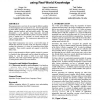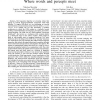966 search results - page 104 / 194 » The Design of Evolutionary Process Modeling Languages |
IUI
2003
ACM
14 years 29 days ago
2003
ACM
This paper presents a novel way for assessing the affective qualities of natural language and a scenario for its use. Previous approaches to textual affect sensing have employed k...
CEFP
2005
Springer
14 years 1 months ago
2005
Springer
This chapter describes Hume: a functionally-based language for programming with bounded resource usage, including time and space properties. The purpose of the Hume language design...
IROS
2006
IEEE
14 years 1 months ago
2006
IEEE
— Our long-term objective is to develop robots that engage in natural language-mediated cooperative tasks with humans. To support this goal, we are developing an amodal represent...
CHI
2006
ACM
14 years 8 months ago
2006
ACM
icians or philosophers use abstract symbols to derive formulas or form proofs. Indeed, these sketches are structural geometric proofs, consistent with Plato's supposition that...
FDL
2007
IEEE
14 years 2 months ago
2007
IEEE
Actor-oriented modeling approaches are convenient for implementing functional models of embedded systems. Architectural models for heterogeneous system-on-chip architectures, howe...


